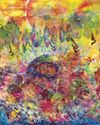
This girl lives in an artists’ colony in Delhi. Although her makeshift water bucket says power Supreme’, India is a country where many people are disempowered, by both gender and caste. This is not America, where anyone can be President. The odds are stacked against a poor girl becoming the Prime Minister of India, or attaining any position of power, supreme or otherwise. She’s carrying water because her home has no plumbing. Her mother cooks out in the open air, over a fire on the ground. I hope that the girl has a flourishing life, whatever direction it takes.
The artists in the colony are professional snake charmers, magicians, drummers and dancers. Despite their grim living conditions, the residents were welcoming. I was offered home-cooked food by people who probably didn’t have enough to eat, but I didn’t insult them by refusing.
I was there to teach local children some Irish jigs and hornpipes on the tin whistle. (The next time you’re in Delhi listen out for any Indian street musicians playing jaunty Irish tunes – and maybe give a decent tip to one of my former students.) In return, they taught me a Hindi song made famous by Bollywood megastar Shah Rukh Khan. I performed it on a bridge in Paris recently and some Indian tourists filmed me on their phones. There are some self-righteous folks who would complain about my ‘appropriation’ of Indian culture, but such sniping is never from Indians. In fact, Shah Rukh Khan himself retweeted the video of me singing his song, playing the flute, and dancing. It went viral for a while, earning the approval of an astounding number of Indians. My musical performance was rightly seen as homage, not appropriation. But I enjoyed the absurdity of achieving brief international fame as a clodhopping dancer.
Diese Geschichte stammt aus der February/March 2020-Ausgabe von Philosophy Now.
Starten Sie Ihre 7-tägige kostenlose Testversion von Magzter GOLD, um auf Tausende kuratierte Premium-Storys sowie über 8.000 Zeitschriften und Zeitungen zuzugreifen.
Bereits Abonnent ? Anmelden
Diese Geschichte stammt aus der February/March 2020-Ausgabe von Philosophy Now.
Starten Sie Ihre 7-tägige kostenlose Testversion von Magzter GOLD, um auf Tausende kuratierte Premium-Storys sowie über 8.000 Zeitschriften und Zeitungen zuzugreifen.
Bereits Abonnent? Anmelden

Metaphors & Creativity
Ignacio Gonzalez-Martinez has a flash of inspiration about the role metaphors play in creative thought.

Medieval Islam & the Nature of God
Musa Mumtaz meditates on two maverick medieval Muslim metaphysicians.

Robert Stern
talks with AmirAli Maleki about philosophy in general, and Kant and Hegel in particular.

Volney (1757-1820)
John P. Irish travels the path of a revolutionary mind.

IT'S A WONDERFUL LIFE
Becky Lee Meadows considers questions of guilt, innocence, and despair in this classic Christmas movie.

"I refute it thus"
Raymond Tallis kicks immaterialism into touch.

Cave Girl Principles
Larry Chan takes us back to the dawn of thought.

A God of Limited Power
Philip Goff grasps hold of the problem of evil and comes up with a novel solution.

A Critique of Pure Atheism
Andrew Likoudis questions the basis of some popular atheist arguments.

Exploring Atheism
Amrit Pathak gives us a run-down of the foundations of modern atheism.